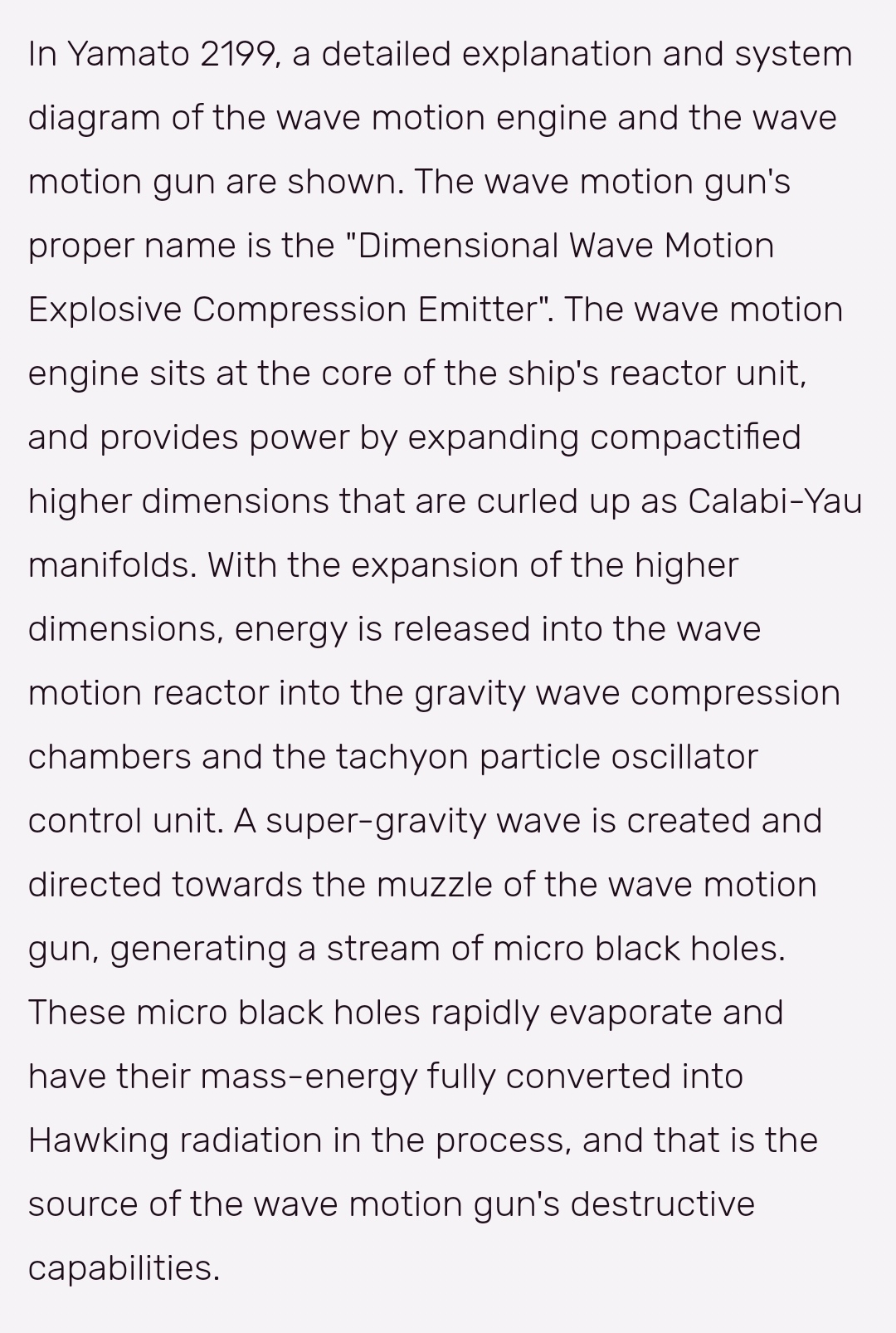This is the first time I've ever actually read a description of how the Space Battleship Yamato's cannon is actually meant to work.

I was curious about this because... there's some physics in there at least, so I busted out half a scrap of paper in lieu of an actual envelope.
I wrote an explanation based on my interpretation thusly:
- Every object in the universe has a gravity field, and should be attracted to every other object (like a magnet)
- But we don't observe this IRL, because gravity is ridiculously weak compared to other forces like magnetism. You need moon-sized objects to see a substantial effect - gravity will never overcome the North poles of two magnets from repelling each other. This is called the "hierarchy problem" (legit science)
- String theory believes that gravity acts through "Large Extra Dimensions", so its strength gets spread out and weakened where we can't see it. For some reason this doesn't happen for other forces (this is questionable science)
- The wave motion engine takes normal material, like rocks or literally anything, and flattens the extra dimensions so the gravity field is suddenly really strong. Like a billion-billion-billion times stronger. Your 1kg rock now weighs 1,000,000,000,000,000,000,000,000,000 kg, an instant black hole (this is straight sci-fi, and also me trying to interpret their description)
- Shoot the black holes out of your gun at the enemy (science??)
- For the right size of black hole, they'll quickly decay and dump energy into the target (legit science)
These are some reeeeeeally fudged numbers, but I think if you started with a few specks of dust, it'd transform that into a 2 kiloton black hole that you fire out of the gun.
The black hole would last for ~11min before evaporating completely, and while doing so it'd be pumping out 1 million megawatts of heat. In contrast, the Three Gorges hydro plant in China puts out a puny 22,500 megawatts of power. That's over 44 times the largest power plant in the world.
Or uhhh... about a third of the entire world's power generation capacity 😂
Disclaimer: all the maths I did is horrible, using equations taken from Wikipedia without checking they're correctly applied. I've definitely messed something up somewhere.
How do you want to do this?
We first need to find out how much of an effect gravity inflation is going to have. Using the hierarchy problem as our reference, it cites the weak force being 1024 times stronger than gravity. Further down the page it suggests a factor of 4×1029. With absolutely no objective basis for doing so, let's pick 1027 as our multiplier because that happens to be "billion-billion-billion", which is snappy to quote.
When inflated, 1kg becomes 1,000,000,000,000,000,000,000,000,000kg, nice.
Now how big a black hole do we want? This is usually measured in solar masses as a matter of convenience, but we can work in kilograms as needed. The premise here is that the black hole evaporates via Hawking radiation, and it's lifespan scales as the cube of its mass. A black hole of one solar mass (2×1030 kg) will take 2.1×1067 years to decay, which is waaaaaay too long for us. We want our black holes to decay in a matter of seconds or minutes. We're gonna need a much smaller black hole.
Let's aim for a lifespan of about 10min (it's a slow space battle), that's about 0.00002 years, or 2×10-5 in scientific notation. This is convenient because we can cancel the 2.1 with the 2, and we're left with turning 1067 into 10-5 with a mass-scaling factor (let's call it F). F×1067 = 10-5, so F=10-72. Now this scaling factor is the ratio of (Mblackhole/Msolar)3, which tells us that our blackhole is 1/1024 the mass of the sun. That sounds miniscule, but you have to remember that the sun is really, really, really big. 2×1030kg big.
Our blackhole is 2×106kg in mass, only 2 kilotonnes! That's about the weight of the Space Shuttle. With the knowledge now that there's a cubic factor in play, we can halve the mass and reduce the lifetime by a factor of 8. A 1 kilotonne black hole will evaporate in 82 seconds, which may be better for space battlin'.
What's the pre-inflation mass of this black hole by the way? Simply divide 2 kilotonnes by 1027 and we get 2×10-21 kg, this is seriously tiny. Our pre-blackhole is on the scale of a strand of DNA, or a fine particle of dust.
How much energy does our black hole emit as it evaporates? We know a couple of things. As a blackbody radiator its temperature scales inverse-linearly with mass. One solar mass would emit at 6×10-8 Kelvin, and the sun is 1024 times the mass of our black hole, so our black hole's temperature is 6×1016 Kelvin. As a reference point, the Chinese tokamak facility hit 1.2×108 in January 2022, so it's reeeeeally really hot. In practice this probably means it's emitting xrays or gamma rays as it evaporates, ie. more energetic than just visible light.
What's this energy in more meaningful terms? Well we have a luminosity (radiated power) equation, I guess that'll do us. I get about 8.948 × 1011 uhh... Watts I think? If so then we're most of the way to a single Terawatt, or 894,800 MW for comparison purposes. We said the Three Gorges dam is putting out 22,500 MW, so we're about 40 times the biggest powerplant in the world, or a third of the entire world's production capacity.